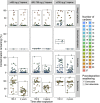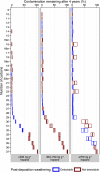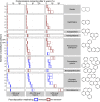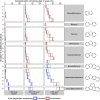Persistence and biodegradation of oil at the ocean floor following Deepwater Horizon
- PMID: 27994146
- PMCID: PMC5224388
- DOI: 10.1073/pnas.1610110114
Persistence and biodegradation of oil at the ocean floor following Deepwater Horizon
Abstract
The 2010 Deepwater Horizon disaster introduced an unprecedented discharge of oil into the deep Gulf of Mexico. Considerable uncertainty has persisted regarding the oil's fate and effects in the deep ocean. In this work we assess the compound-specific rates of biodegradation for 125 aliphatic, aromatic, and biomarker petroleum hydrocarbons that settled to the deep ocean floor following release from the damaged Macondo Well. Based on a dataset comprising measurements of up to 168 distinct hydrocarbon analytes in 2,980 sediment samples collected within 4 y of the spill, we develop a Macondo oil "fingerprint" and conservatively identify a subset of 312 surficial samples consistent with contamination by Macondo oil. Three trends emerge from analysis of the biodegradation rates of 125 individual hydrocarbons in these samples. First, molecular structure served to modulate biodegradation in a predictable fashion, with the simplest structures subject to fastest loss, indicating that biodegradation in the deep ocean progresses similarly to other environments. Second, for many alkanes and polycyclic aromatic hydrocarbons biodegradation occurred in two distinct phases, consistent with rapid loss while oil particles remained suspended followed by slow loss after deposition to the seafloor. Third, the extent of biodegradation for any given sample was influenced by the hydrocarbon content, leading to substantially greater hydrocarbon persistence among the more highly contaminated samples. In addition, under some conditions we find strong evidence for extensive degradation of numerous petroleum biomarkers, notably including the native internal standard 17α(H),21β(H)-hopane, commonly used to calculate the extent of oil weathering.
Keywords: Deepwater Horizon; biodegradation; hydrocarbon; oil spills; petroleum biomarkers.
Conflict of interest statement
The authors declare no conflict of interest.
Figures






References
-
- White HK, et al. Long-term persistence of dispersants following the Deepwater Horizon oil spill. Environ Sci Technol Lett. 2014;1(7):295–299.
-
- Socolofsky SA, et al. Intercomparison of oil spill prediction models for accidental blowout scenarios with and without subsea chemical dispersant injection. Mar Pollut Bull. 2015;96(1-2):110–126. - PubMed
Publication types
MeSH terms
Substances
Associated data
LinkOut - more resources
Full Text Sources
Other Literature Sources
Medical

